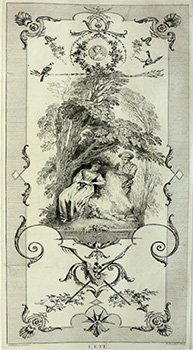
- Home Page
- Accepted
Paintings & Copies - Doubtful
Attributions - Doubtful Textual References
- Alternative
Titles - Collectors &
Museums - Bibliography
- Search Abecedario
- Watteau &
His Circle
L'Heureux moment
Entered January 2024; revised October 2025
Whereabouts unknown
Materials unknown
Measurements unknown
RELATED PRINTS

Louis Crépy fils after Watteau, L’Heureux moment, c. 1729, engraving.
Louis Crépy fils' engraving after L’Heureux moment was issued as one of four prints bound in a volume titled, Ornemens gravé d'après Vatteau. The collection was announced for sale in the April 1729 issue of the Mercure, p. 750.
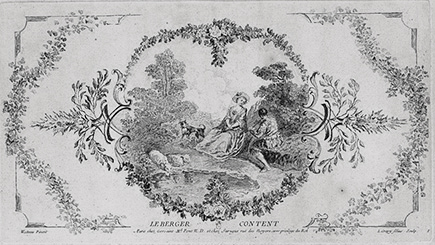
Louis Crépy fils after Watteau, Le Berger content, engraving.
L’Heureux moment and its pendant, Le Berger content, also engraved by Crépy, were announced as part of a suite of four decorative designs. The other two, Le Marchand d’orvietan and La Favorite de Flore, were engraved by Jean Moyreau. Those figures are set to a different scale and the decorative surrounds are unrelated to those in the first two. In other words, the two sets of arabesques are unrelated visually.
SELECT BIBLIOGRAPHY
Mariette, “Notes manuscrites,” 9: fol. 198.
Goncourt, L’Art au XVIIIème siècle (1860), 59.
Cellier, Watteau (1867), 85.
Goncourt, Catalogue raisonné (1875), 221, cat. 303.
Dacier, Vuaflart, and Hérold, Jean de Jullienne et les graveurs (1921-29), 2: 28, 58, 61, 133 n. 2, 130, 133, 160; 3: cat. 10.
Rahir, Watteau, peintre d’arabesques (1922), cat. 67.
Réau, “Watteau” (1928), cat. 270.
Adhémar, Watteau (1950), cat. 29.
Macchia and Montagni, L’opera completa di Watteau (1968), cat. 39D.
Cailleux, “A Strange Monument” (1975), 247.
Rosenberg and Prat, Watteau, catalogue raisonné des dessins (1996), cat. 163.
Eidelberg, “How Watteau Designed His Arabesques” (2003), 71-72, note 25, 27.
Michel, Le «célèbre Watteau» (2008), 184.
Eidelberg, “Le Berger content” (2016), http://watteau-abecedario.org/berger_content.htm.
RELATED DRAWINGS
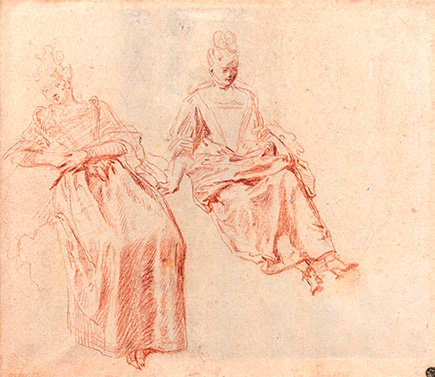
Watteau, Studies of Two Seated Women, red chalk, 16.4 x 20 cm. Whereabouts unknown.
The shepherdess with her hands folded together in L’Heureux moment is based on a red chalk drawing (Rosenberg and Prat 163) that recently appeared at auction (Paris, June 16, 2020, lot 65).
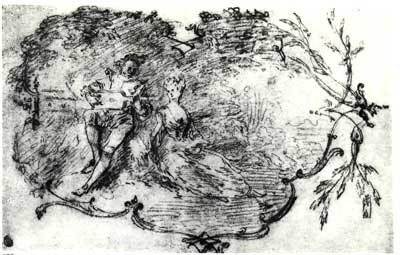
Watteau, An Arabesque with a Music-Making Couple, sanguine, 18.2 x 29.5 cm. Whereabouts unknown.
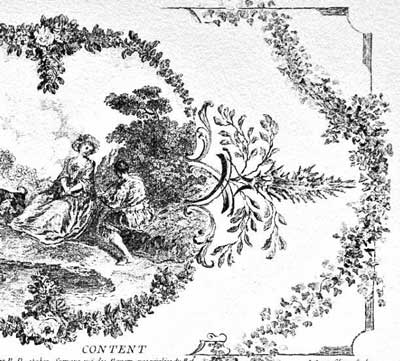
Louis Crépy fils after Watteau, Le Berger content (detail).
The arabesque enframement of Le Berger content can also be traced to a Watteau drawing. The bilateral arrangement of leafy branches and arcs is derived directly from a drawing that has not been seen for many decades (Rosenberg and Prat R658). This drawing, accepted by Parker and Mathey, Grasselli, and myself, was rejected by Rosenberg and Prat. However, it conforms in every aspect to the way in which Watteau planned his arabesques. The figures are drawn rapidly but precisely, and he has offered two different solutions for the decorative enframement. He chose the design on the right side for Le Berger content and its pendant, L’Heureux moment, but added a horizontal branch to the central axis.
REMARKS

Louis Crépy fils after Watteau, L’Heureux moment, engraving.

Louis Crépy fils after Watteau, Le Berger content, engraving.
When the print of L’Heureux moment was issued, it was one of a suite of four arabesques, the other three being La Favorite de Flore, Le Marchand d’orviétan, and Le Berger content. L’Heureux moment was evidently paired with Le Berger content. Both feature a central medallion within a foliated frame that has spearlike protrusions of vegetal matter extending out horizontally. In contrast, the other two arabesques feature central motifs set within arcs of vegetation and spiral rinceaus in the lower corners. L’Heureux moment and its pendant are linked not only in terms of their decorative schemes but are also linked thematically: both portray visions of a bucolic, pastoral world—a shepherd serenading his love in one, and a young man coming upon an unchaperoned, sleeping shepherdess in the other.
The design of Le Heureux moment was also used in another series of arabesques, La Paravent Carignan (also known as the Saisons ovales), where it appears in the guise of an allegory of summer. The figural portion was repeated with little change, but the trees were modified and the ornamental portion is totally different. It is rare to find Watteau repeating himself so rigorously.
As can be expected, the scholars who have considered L’Heureux moment have disagreed about its date. Adhémar placed it c. 1708-09, and Macchia and Montagni preferred c. 1709, but Rosenberg and Prat dated the drawing of the two women to c. 1712, which implies that the painting was exectuted then or still later.
The caption beneath the engraved image declares “Watteau pinxit,” but there is no record of such a painting, not in eighteenth-century lists or in more modern inventories or sale catalogues. Mariette in his Notes described Favorite de Flore and Heureux moment as “compositions d’ornements propres pour des dessus de portes” [compositions for overdoor paintings].
For copies of L'Heureux moment CLICK HERE

